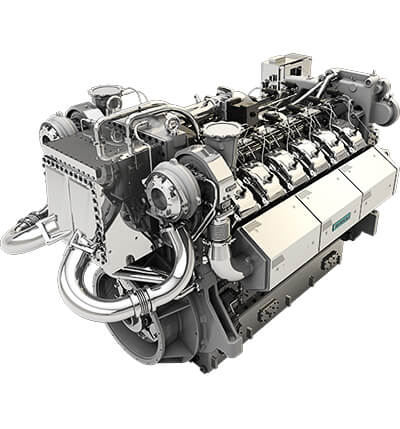Editor’s note: The generators introduced here would compliment well the output of a wind farm so as to make its natural variability invisible.
Siemens has launched a natural gas engine E-series with a power output of two megawatts. It includes the SGE-86EM for the 50-Hz market and the SGE-100EM for the 60-Hz market. The new E-series engine has 12 cylinders and offers a large volume per cylinder, high displacement, and best-in-class efficiency in the market. With the new 2-MW SGE-86EM and the SGE-100EM engines, Siemens is providing a broader spectrum of efficient products and solutions for clean, low-MW-range distributed power generation.

Siemens has launched its new natural gas engine E-series with a power output of two megawatts. It includes the SGE-86EM for the 50-Hz market and the SGE-100EM for the 60-Hz market.
In 2015 Siemens acquired Guascor engines and generator sets as part of the Dresser-Rand product portfolio. The name of these engines now includes “SGE,” for Siemens Gas Engine. Legacy Guascor engines are recognized as robust and efficient machines that deliver heat and power and perform reliably in critical and demanding applications. These products are engineered and tested under rigorous conditions. With roots dating back half a century, approximately 4,700 Guascor engines are operating in more than 50 countries around the world. Siemens’ expanded portfolio now ranges from 300 kW to 2 MW for the gas engines; 4 to 66 MW for industrial and aero derivative gas turbines; and up to 425 MW for heavy-duty gas turbines.
The new E-series gas engine is based on the thermodynamic Miller cycle combustion technology that ensures high reliability, minimal emissions, and longer run times between service intervals. With a mechanical efficiency of about 47 percent and an electrical efficiency of 45.4% the engine offers a high level of performance for both prime power generation and cogeneration applications. The new engine series’ capacity to deliver on-site power, heat, and cooling for a wide variety of commercial, industrial, and municipal applications translates into an excellent cost-performance ratio. With more than 3,000 operating hours and comprehensive testing at Siemens’ Engine R&D Center in Miñano, Spain, demonstrated a reliable, efficient engine with competitive capital and operating costs.
“The new E-series engine offers a more compact and efficient alternative to the 2-MW engines available in the power generation market today,” said Eva Garmendia, product line manager. “We can also offer one of the shortest lead times in the industry, with just 24 weeks from concept to delivery of a complete gen-set.”
The new engine series is the result of in-depth market research that identified key product benefits. “In turn, this new E-series gas engine offers our clients the best-in-class alternative on the market, highest efficiency, excellent reliability, proven technology, and the smallest footprint: 34.5 cubic meters,” said Iñaki Iruretagoiena, R&D Director for Engines.
Siemens E-series engines are especially well-suited for renewable energy and waste-to-energy, industrial power generation and cogeneration, and combined heat and power (CHP) applications. By generating electricity on-site and recovering heat typically wasted in a conventional power plant, CHP technology reduces energy costs and carbon emissions.
CHP is a common application used by large building complexes, like the one planned for the Siemens Campus in Erlangen, Germany. The Erlangen Campus will create a new urban district and debut as Siemens’ first CO2-neutral location worldwide. In collaboration with Erlangen’s municipal utility, the campus will operate on a CO2-neutral basis, thanks to state-of-the-art building and energy technology.
A decentralized energy system that uses a separate cogeneration system based on four new SGE-86EM engines will provide district heating and cooling for the campus. This system will be combined with a single concept to adapt to the existing energy infrastructure and will eliminate expensive development or expansion of the existing infrastructure. The units are expected to be delivered to the site in 2018.
Filed Under: News, O&M





Jacob, in the US we would expect to run about 1.2-1.4 million dollars on a unit like that.
Any estimation on how much this may cost? I am a student at Worcester Polytechnic Institute working on a project that would design a cogeneration plant at WPI with the use of a 2mw natural gas generator.